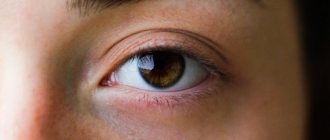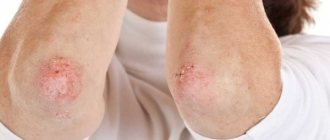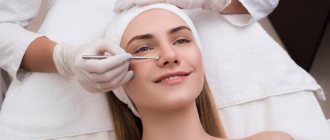The eyes are called the mirror of the soul, so it is not surprising that many people first of all pay attention to them. Circles forming under the eyes cause women many problems and worries. They try to disguise the flaw with the help of correctors and foundations. But this way cannot solve the problem. You can only hide it, and only temporarily. In order to radically eliminate the defect, it is necessary to first determine the cause, conduct a diagnosis and, only based on the results obtained, select treatment methods.
Diseases
Not always, swelling and bruising under the eyes are a sign of an unhealthy lifestyle. Often, the reason is the presence of certain diseases:
- Allergies. Accompanied by lacrimation, sneezing, redness of the eyes, difficulty breathing and coughing;
- Inflammation of the sinuses (sinusitis and sinusitis). They occur with painful sensations localized in the forehead and under the eyes, as well as copious discharge from the nose;
- Kidney diseases. When they occur, fluid retention occurs in the body, which causes not only swelling of the eyes, but also lower back pain and headaches;
- Diseases of the thyroid gland. Due to dysfunction of the thyroid gland, hormonal imbalance occurs - general weakness increases, body weight increases, the menstrual cycle changes, edema occurs;
- Heart failure. It is accompanied by shortness of breath and fatigue. Swelling and bruising under the eyes, almost invisible in the morning, appear in the late afternoon;
- Skin diseases - eczema and dermatitis.
Causes of the defect
All known factors that can provoke the formation of dark circles around the eyes are divided into 3 groups:
Lifestyle
Quite often, circles under the eyes appear due to an unhealthy lifestyle:
- poor nutrition leading to vitamin deficiency;
- insufficient water consumption;
- strong insolation;
- constant lack of sleep;
- frequent stressful situations;
- sitting for many hours in front of a computer monitor.
Therefore, most people are at risk. But it is the factors of this group that are easiest to eliminate, since they are reversible and easily corrected.
Diseases of internal organs
Dark circles under the eyes can occur in people with impaired venous or lymphatic drainage. The cause of such conditions is insufficient blood supply (ischemia) and oxygen deficiency (hypoxia). As a result, metabolism is disrupted, causing insufficient nutrients to reach the cells. Therefore, dark circles are often noticeable in people with diagnosed diseases of the cardiovascular (coronary heart disease, vascular insufficiency) and bronchopulmonary (chronic bronchitis, tuberculosis, sarcoidosis, fibrosing alveolitis) systems.
In patients suffering from anemia, the number of red blood cells decreases and the concentration of hemoglobin decreases, which is why the tissues do not receive enough oxygen. At the same time, the reduced hemoglobin accumulates and gives the blood a dark color, which explains the change in color of the skin around the eyes.
Pathologies of the hepatobiliary system (cholecystitis, cholelithiasis) increase the level of bile pigment (bilirubin) in the blood. As a result, the skin in the periorbital area becomes pigmented and turns yellow-brown.
Damage to the thyroid gland (including hypothyroidism) causes a lack of oxygen in the body, which causes bruises to appear under the eyes. In this case, other signs are observed: hair loss, unbearable heat and cold, weakening of attention and memory, drowsiness, lethargy, rapid fatigue.
Diseases of the nasopharynx (sinusitis, sinusitis, chronic tonsillitis, adenoiditis) dilate the blood vessels, which leads to their excessive filling with blood and blueness of the skin under the eyes.
In acute infectious diseases accompanied by an increase in body temperature, intoxication occurs with the metabolic products of microbes. As a result, the acidity of the blood increases and acidosis develops, in which the vessels dilate and their permeability increases. Intoxication syndrome causes dehydration. On dry and thin dehydrated skin, dilated capillaries become especially noticeable, which creates the effect of dark circles.
Diseases of the adrenal glands and kidneys increase pigmentation of the skin surrounding the eyes. With chronic adrenal insufficiency (Addison's disease), the skin also darkens in natural folds (groin, palms) and in areas exposed to friction by clothing (lower back, neck). With kidney pathologies (pyelonephritis, glomerulonephritis), blue circles under the eyes become noticeable when the disease relapses due to a malfunction of the organ.
Women often suffer from hyperpigmentation during hormonal changes (during pregnancy, menopause) due to an imbalance of female sex hormones (estrogen, progesterone).
In case of inflammatory eye diseases (conjunctivitis, iridocyclitis), swelling appears under the eyes, the permeability of capillaries increases, which is why they become more noticeable and begin to “see through” the skin.
With vegetative-vascular dystonia (the so-called polyetiological syndrome, which is not a disease), bruises under the eyes also often form. At the same time, other signs appear: migraine, dizziness, asthenia, cardialgia, changes in heart rate and breathing, swelling of tissues, tremors of the hands, coldness of the extremities, feeling of heat in the face, sleep disturbance, fainting, neurotic disorders.
The maximum number of mast cells accumulates in the periorbital region, which causes the reactivity of the skin surrounding the eyes and frequent allergies. In diseases of an allergic nature (allergic rhinitis, hay fever), blood vessels dilate and their permeability increases, as a result of which the skin under the eyes darkens.
Hereditary predisposition
This group includes people who lead a healthy lifestyle and do not have health problems. For them, dark circles under the eyes are the norm. This problem is more common in women with very dry and dark skin.
It should be noted that the risk of hyperpigmentation of the skin in the periorbital zone increases with the use of tetracyclines, sulfonamides and oral contraceptives.
All of the above factors are enhanced by excessive exposure to ultraviolet radiation. In this case, the defect becomes stable and difficult to treat.
How to remove circles under the eyes of a man
To finally get rid of circles under the eyes, it is first important to determine their cause.
- It is the disease that needs to be treated, not the symptom, so if you suspect that bruises are a consequence of health problems, it is important to consult a doctor immediately.
- To eliminate dark circles under the eyes caused by lack of sleep, dehydration or poor diet, normalize your lifestyle and diet. Sleeping for 7-8 hours, sufficient amounts of clean water and a balanced diet will help get rid of dark circles and improve the overall condition of the body.
- If bruises are caused by bad habits, stop drinking alcohol and smoking cigarettes.
- If you have bruises caused by eye strain while working at a computer, try to take plenty of rest from the monitor. Take five-minute breaks. It is useful to do eye exercises during such breaks.
- A massage with ice cubes will help remove blue under the eyes. The cooling effect has a beneficial effect on blood vessels.
Cosmetologist Ekaterina Strokina associates dark circles under the eyes in men with thinning of the skin in the eye area and dilated veins - and recommends a simple exercise that will help get rid of blue under the eyes, unless, of course, it is caused by health problems.
Preventive actions
To prevent the formation of dark circles under the eyes, it is recommended:
- adhere to a regime of wakefulness and rest;
- eat a balanced diet;
- maintain water regime;
- take vitamin and mineral supplements;
- to refuse from bad habits;
- do eye exercises;
- avoid direct sunlight to reduce insolation;
- use high-quality perfumes and cosmetics;
- walk in the fresh air more often;
- avoid stressful situations.
Other methods of dealing with bruises
Another effective method of cleansing the space around the eyes is the use of folk remedies.
| Main active ingredient | Mode of application | Time of action |
| Sauerkraut | Grind on a grater (in a food processor, blender). Apply to face. | 15 minutes (remove with a napkin, wash with cool water). |
| Cherry | Crush a few ripe cherries on your face | 15 minutes (after use, rinse with cool water). |
| Cottage cheese | Apply under eyes. Has an almost immediate effect | 15 minutes |
| Parsley and cucumber | The components are crushed and mixed in equal proportions | Apply on eyelids for 15 minutes. |
Do not forget that the body is capable of responding with an allergy to the use of one or another component. Therefore, you should use certain treatment methods with caution.
Folk remedies bring results only when used systematically. The course of procedures should last about two months.
[media=
https://youtu.be/JcvbA2MVR3g
]
Why do bruises appear under the eyes: anatomical features
The skin under the lower eyelid is several times thinner than on other parts of the body and contains a large number of blood vessels and small capillaries. And the vessels, capillaries, and muscles that are located under the epidermis are darker than our skin, so if they are visible, visually it will look like bruises under the eyes. The effect also occurs when the permeability of the walls of blood vessels and capillaries is disrupted.
The lower layer of the epidermis is subcutaneous fat. In some areas of our body (for example, the border of the lips) it is completely absent. Under the lower eyelid, the layer of subcutaneous fat is quite small, so any thinning of it leads to dark circles appearing under the eyes.
Thus, there are three anatomical causes of bruises under the eyes:
- very thin layer of dermis;
- thinning of the fat layer under the lower eyelids;
- violation of the permeability of vascular walls.
Let's take a look at the anatomical structure of the eye area.
To understand the reason for the formation of circles, you need to imagine the structure of this area. Let's remember our school anatomy lessons.
Under the skin there is fat hidden - the so-called “fat packets of the face”. Below them are the orbicularis oculi muscles: they are responsible for squinting, squinting, blinking and other facial expressions.
Let's pay attention to the orbit of the eye and remember how many blood vessels and capillaries there are in this area.
It is very important to understand that blood vessels and muscle tissue are rather “dark” formations that are not very visible “on the face” only thanks to the skin and subcutaneous fat that cover these structures. Thus, skin and fat are the main concealers of dark circles under the eyes.
Thinning of the fat layer
The most common cause of dark circles. The skin of the lower eyelids is separated from the orbicularis oculi muscle and blood vessels by a thin layer of superficial fat.
With age, the superficial fat becomes thinner, “goes away,” and even through the thickest skin the orbicularis oculi muscle and blood vessels begin to show through. The muscle is dark red, the vessels are blue-scarlet.
The color of the circles depends on what is more visible - the blood vessels or the muscle. The color of dark circles has no connection with the kidneys, liver and other organs.
It happens that there is very little subcutaneous fat - this is a genetic feature. Then dark circles and semicircles can be seen from childhood.
Thin skin
The skin of the lower eyelids is the thinnest on the entire body. There is a thin layer of fat under the skin, but if there is little fat and the skin is thin, then the same vessels and muscles can be seen through the light. If your blood vessels are located close to the skin , and your skin is light, then it can show through even if there is fat!
Deep-set eyes
The lower eyelid is spatially located in the projection of the orbit of the skull. Anatomically deep-set eyes visually create a “retraction” of the skin relief in the area of the lower eyelid; when illuminated, a shadow part is formed in this area, which visually creates the effect of a dark circle.
To better understand this point, let's look at a visualization of another deficiency - the nasolacrimal trough depending on lighting.
Any age-related problem - be it a wrinkle, a bag, a hernia or bad skin - is noticeable thanks to only one thing: incident and reflected light.
The main essence of anti-aging aesthetic corrections is working with the distribution of light and shadow on our face. Any furrow, fold or bag is a play of light. Look at the illustrations to see how the visual appearance of the nasolacrimal trough varies depending on the direction of the lighting.
We all understand that both daytime natural and artificial light falls mainly on our face from above. It is this direction of lighting that most clearly emphasizes all the irregularities on the face!
It’s the same with deep-set eyes - the darkness of the lower eyelid depends to a greater extent on the lighting.
Dark circles from pigmented skin
Acquired and congenital pigment is the cause of the formation of dark circles in a normal anatomical structure. The peoples of the Caucasus region have a genetic predisposition to pigmented skin of the lower and upper eyelids.
Pigmentation can appear with age; usually such dark circles do not have a clear border at the bottom.
Treatment methods
If the diagnosis does not reveal internal diseases, then circles under the eyes are a cosmetic defect that appears as a result of an incorrect lifestyle or hereditary predisposition.
In such cases, the most popular and effective treatment methods are:
- Mesotherapy. Typically, meso-cocktails are used, which contain arbutin, ascorbic, kojic and phytic acids. The therapeutic course includes 6-10 procedures, between which there is a one-week break.
- Bioreparation with ascorbic acid (vitamin C). Thanks to the combination of ascorbic and hyaluronic acid, the skin around the eyes is well moisturized and noticeably brightened. The course of treatment consists of 2-4 sessions, with a 2-week break between them.
- Plasmolifting. The procedure restores metabolism, normalizes tissue respiration, activates blood microcirculation, thereby increasing local immunity. A similar effect will appear after 4-6 sessions at weekly intervals.
- Biorevitalization. The skin around the eyes shows a pronounced reaction to dehydration and, due to dryness, often takes on an unaesthetic appearance, creating the effect of “tired eyes”. A course of birevitalization, consisting of 2-4 procedures with a 2-week interval, will help solve the problem.
- Contour plastic. If the blood vessels are located close to the skin and “see through” through it, then the filler forms an additional layer, making the vessels almost invisible. In addition, the drugs smooth out the nasolacrimal groove.
- Laser peeling. Using a laser, the top layer of skin is removed, which stimulates the regeneration process and promotes rejuvenation. The treatment course involves 2-5 procedures with a one-month break.
Diagnostics
To exclude diseases of internal organs, you should undergo comprehensive instrumental and laboratory diagnostics, including:
- general and biochemical blood test;
- hormone tests:
- thyroid gland (thyroid-stimulating hormone, free T4);
- produced by the adrenal glands (adrenocorticotropic hormone, cortisol);
- sexual (progesterone, estrogen);
- organs located in the abdominal region;
It is also necessary to consult with different specialists:
- endocrinologist;
- gynecologist;
- urologist;
- ophthalmologist;
- otolaryngologist;
- gastroenterologist;
- cardiologist;
- allergist.
How to get rid of dark spots under the eyes
You can cure black spots under the eyes in the following ways:
- Drug treatment
. Indicated in cases where a woman is diagnosed with a disease. Having cured the main ailment with the help of medications, the chance to overcome the “bruises” is very high. - General strengthening of the body
. These include: quality sleep, walks in the fresh air, lack of stress and bad habits, exercise, and so on. All these measures will not only greatly improve your appearance, but also significantly improve your health. - Local influencing methods
. Used in various beauty salons. To completely remove stains, procedures are carried out to tone the vessels (biorevitalization, mesotherapy, lipofilling and others). Professional makeup will also help disguise skin imperfections. - Use of cosmetics
.
If you cannot remove the “bruises” for some reason, they can be disguised with the help of cosmetics
.
Foundation will be a good helper. Concealers and BB creams
also do a good job of concealing. These products fill wrinkles around the eyes well, even out skin color, and also moisturize and nourish it.
Vitamin C has a beneficial effect on the skin. This should be taken into account when choosing a face cream (the vitamin should be included in its composition).











